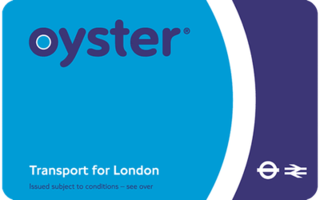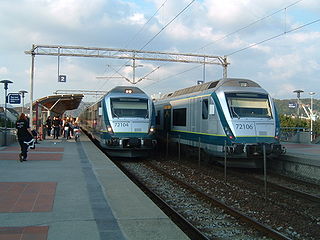
Stavanger is a city and municipality in Norway. It is the third largest city and third largest metropolitan area in Norway and the administrative center of Rogaland county. The municipality is the fourth most populous in Norway. Located on the Stavanger Peninsula in southwest Norway, Stavanger counts its official founding year as 1125, the year the Stavanger Cathedral was completed. Stavanger's core is to a large degree 18th- and 19th-century wooden houses that are protected and considered part of the city's cultural heritage. This has caused the town center and inner city to retain a small-town character with an unusually high ratio of detached houses, and has contributed significantly to spreading the city's population growth to outlying parts of Greater Stavanger.

The Jæren Line 74.7-kilometer (46.4 mi) long railway line between Stavanger and Egersund in Jæren, Norway. The name is no longer in official use and the section is regarded as the westernmost part of the Sørlandet Line. Owned by Bane NOR, the line has double track from Stavanger Station to Sandnes Station, and single track from Sandnes to Egersund Station. The line is electrified at 15 kV 16.7 Hz AC and equipped with centralized traffic control and GSM-R. The line is served by the Jæren Commuter Rail and intercity trains along the Sørlandet Line, both operated by Go-Ahead Norge. CargoNet runs container freight trains on the line, which terminate at Ganddal Freight Terminal.

The Oyster card is a payment method for public transport in London in England, United Kingdom. A standard Oyster card is a blue credit-card-sized stored-value contactless smart card. It is promoted by Transport for London (TfL) and can be used on travel modes across London including London Buses, London Underground, the Docklands Light Railway (DLR), London Overground, Tramlink, some river boat services, and most National Rail services within the London fare zones. Since its introduction in June 2003, more than 86 million cards have been used.

The Travelcard is an inter-modal travel ticket for unlimited use on the London Underground, London Overground, Elizabeth line, Docklands Light Railway, London Trams, London Buses and National Rail services in the Greater London area. Travelcards can be purchased for a period of time varying from one day to a year, from Transport for London, National Rail and their agents. Depending on where it is purchased, and the length of validity, a Travelcard is either printed on a paper ticket with a magnetic stripe or encoded onto an Oyster card, Transport for London's contactless electronic smart card, or an ITSO smartcard issued by a National Rail train operating company. The cost of a Travelcard is determined by the area it covers and, for this purpose, London is divided into a number of fare zones. The Travelcard season ticket for unlimited travel on London Buses and the London Underground was launched on 22 May 1983 by London Transport. One Day Travelcards and validity on other transport modes were added from 1984 onwards. The introduction of the Travelcard caused an increase in patronage and reduced the number of tickets that needed to be purchased by passengers.
Translink is the public transit agency for Queensland, and is part of the Department of Transport and Main Roads. Translink was first introduced by the Queensland Government in June 2003 to orchestrate bus, ferry, rail and light rail services. They work with Brisbane Airtrain, Transport for Brisbane, RiverCity Ferries, Queensland Rail and other operators to provide services. Translink operates an integrated ticketing system across Queensland and the go card system to allow the use of one ticket on multiple services in South East Queensland.
Public transport ticketing in New South Wales, Australia operated using magnetic-stripe technology between 1989 and 2016. This ticketing system, known variously as the Automated fare collection system, STATS and, from 2010, MyZone, was progressively replaced by a contactless smart card called Opal between 2012 and 2016.

Vy Gjøvikbanen AS is a Norwegian railway company that operates the passenger train service on the Gjøvik Line. A subsidiary of the state-owned Vy, it operates a fleet of nine Class 69g three-car electric multiple units. NSB Gjøvikbanen provides two different services: the Skøyen – Oslo S – Jaren service is part of the Oslo Commuter Rail; while Oslo S – Gjøvik is a regional service, with only limited stops on the route until Grua. Departures are each 40 minutes, with every third train running to Gjøvik.

Boreal Norge AS is a Norwegian public transport operator. Established as a subsidiary of CGEA Transport in 1999, it operates through its subsidiaries buses, ferries and trams in the counties of Finnmark, Nordland, Rogaland, Sør-Trøndelag and Troms, primarily through the purchase of former monopolists. The company has 2,500 employees and operates ca 920 buses, 34 ferries/ships and 9 trams.

Stavanger Station is a railway station in Stavanger municipality in Rogaland county, Norway. It is located in the centre of the city of Stavanger and it is the terminus of the Sørlandet Line. The station is served by regional trains to Kristiansand and the Jæren Commuter Rail.

The ORCA card is a contactless, stored-value smart card system for public transit in the Puget Sound region of Washington, United States. The card is valid on most transit systems in the Seattle metropolitan area, including Sound Transit, local bus agencies, Washington State Ferries, the King County Water Taxi, and Kitsap Fast Ferries. It was launched in 2009 and is managed by the Central Puget Sound Regional Fare Coordination Project, a board composed of local transit agencies.

The Ålgård Line is a closed, but not abandoned, railway line between Ganddal and Ålgård in Rogaland, Norway. The 12.24-kilometer (7.61 mi) line was built as a narrow gauge branch line of the Jæren Line by the Norwegian State Railways (NSB) and opened in 1924. It runs through the villages of Foss-Eikeland and Figgjo in Sandnes to Ålgård in Gjesdal. Several proposals were made for the Ålgård Line to become the first part of the main line from Stavanger to Oslo, but instead the Sørlandet Line was connected to the Jæren Line in 1944. At the same time, the Ålgård Line was upgraded to standard gauge.

Jåttåvågen Station is a railway station located in the municipality of Stavanger in Rogaland county, Norway. The station is located at Jåtten in the city of Stavanger, about 7.2 kilometres (4.5 mi) from the main Stavanger Station. It is served by the Jæren Commuter Rail operated by Go-Ahead Norge by up to four hourly trains in each direction. The station is located along the double track section of the Sørland Line, and was opened on 8 January 2009, replacing Jåttå Station. The station is within a minute's walk of Viking Stadion and Jåttå Upper Secondary School. The station is co-located with a Kolumbus bus stop, allowing transfers to and from Line 11.
Mariero Station is a railway station in Stavanger Municipality in Rogaland county, Norway. The station is located at Mariero in the city of Stavanger, about 4.13 kilometres (2.57 mi) from the main Stavanger Station. It is served by the Jæren Commuter Rail operated by Go-Ahead Norge by up to four hourly trains in each direction. The station is located along the double track section of the Sørland Line, and was opened on 16 November 2009. It is co-located with a Kolumbus bus stop, allowing transfer to many routes.

A transit pass or travel card, often referred to as a bus pass or train pass etc., is a ticket that allows a passenger of the service to take either a certain number of pre-purchased trips or unlimited trips within a fixed period of time.
t:kort is a digital ticket used for travel with public transport in Trøndelag, Norway. After its implementation in 2008, t:kort is the only valid ticketing system in the area, valid on bus, coach, tram and ferry transport as well as the Trøndelag Commuter Rail. The ticket is the size of a credit card, and can be charged monthly or as individual tickets.

The Jæren Commuter Rail is a commuter train service operated along the westernmost part of the Sørland Line in Jæren, Norway. It is operated by Go-Ahead Norge with nine Class 72 electric multiple units. The service acts as a commuter rail connecting Stavanger to its suburbs, including Sandnes, and to towns further south, in Klepp, Time, Hå and Eigersund. Although passenger services have operated along the lines since 1878, the commuter train service was inaugurated in 1992 with a significant increase of service, using existing rolling stock. Ridership of the system increased from 3.2 million in 2012 to 5 million in 2019.

Gausel Station is a railway station in Stavanger Municipality in Rogaland county, Norway. It is located at Gausel in the city of Stavanger. Located 9 kilometers (5.6 mi) from Stavanger Station, it is served by the Jæren Commuter Rail operated by Go-Ahead Norge by up to four hourly trains in each direction. The station is located along the double track section of the Sørlandet Line. The original station at Gausel was opened in 1902, and the station building was completed in 1908. This station was closed in 1966. The new station was opened on 16 November 2009 as part of the new double track from Stavanger to Sandnes. It is co-located with a Kolumbus bus stop, allowing transfer to several routes.

Paradis Station is a railway station in Stavanger Municipality in Rogaland county, Norway. The station is located at Paradis in the city of Stavanger, about 1.4 kilometres (0.87 mi) from the main Stavanger Station. It is served by the Stavanger Commuter Rail operated by Go-Ahead Norge by up to four hourly trains in each direction. The station is located along the double track section of the Sørlandet Line, and was opened on 16 November 2009, replacing Hillevåg Station. It is co-located with a Kolumbus bus stop, allowing transfer to many routes.

The AT HOP card is an electronic fare payment card that was released in two versions on Auckland public transport services, beginning in May 2011. The smart card roll out was the first phase in the introduction of an integrated ticketing and fares system that was rolled out across the region.

Opal is a contactless smartcard fare collection system for public transport services in the greater Sydney area and most other urban areas of New South Wales, Australia. Operation of the Opal system is managed by the New South Wales Government's transport authority, Transport for NSW. First launched in late 2012, Opal is valid on Transport for NSW's metro, train, bus, ferry and light rail services that operate in Sydney and the neighbouring Central Coast, Hunter Region, Blue Mountains, Illawarra and Southern Highlands areas. Opal equipment was designed from the start to support a variety of cards, but launched with the captive Opal cards.


















